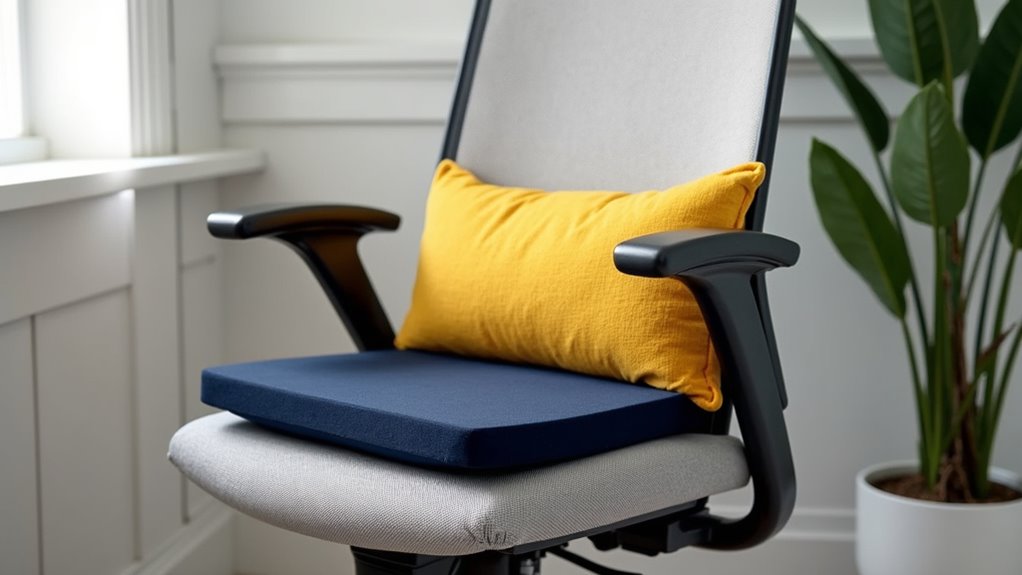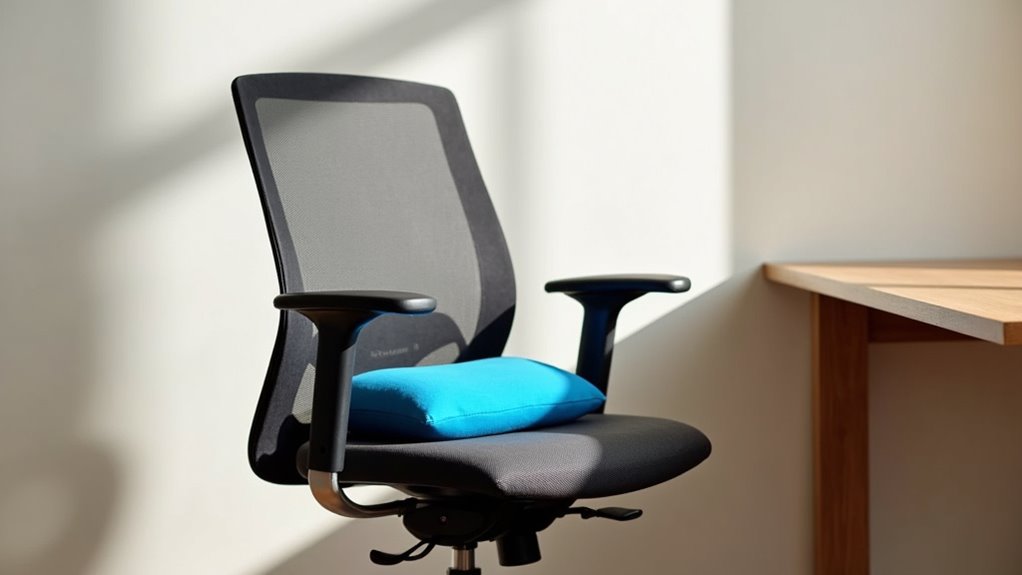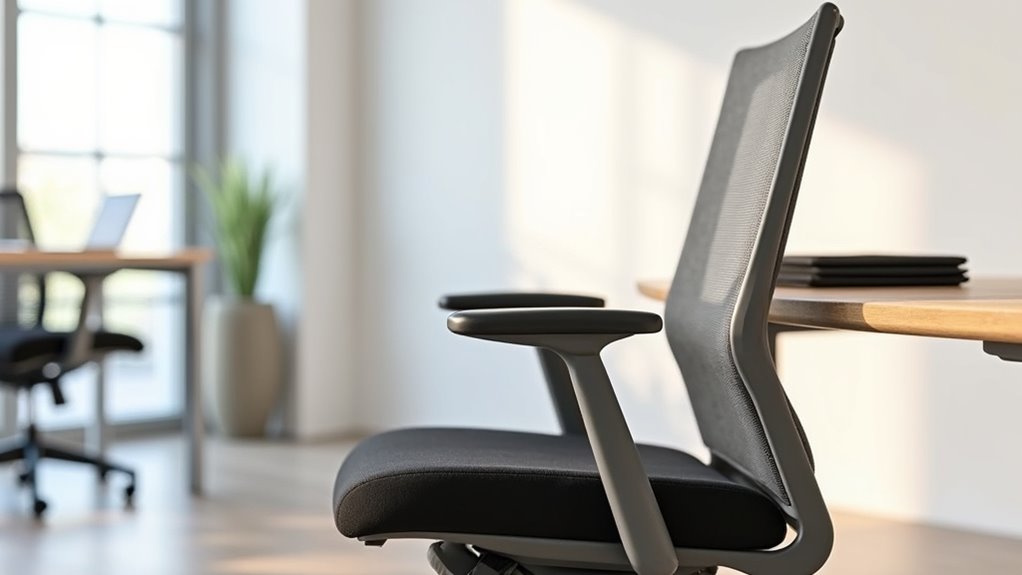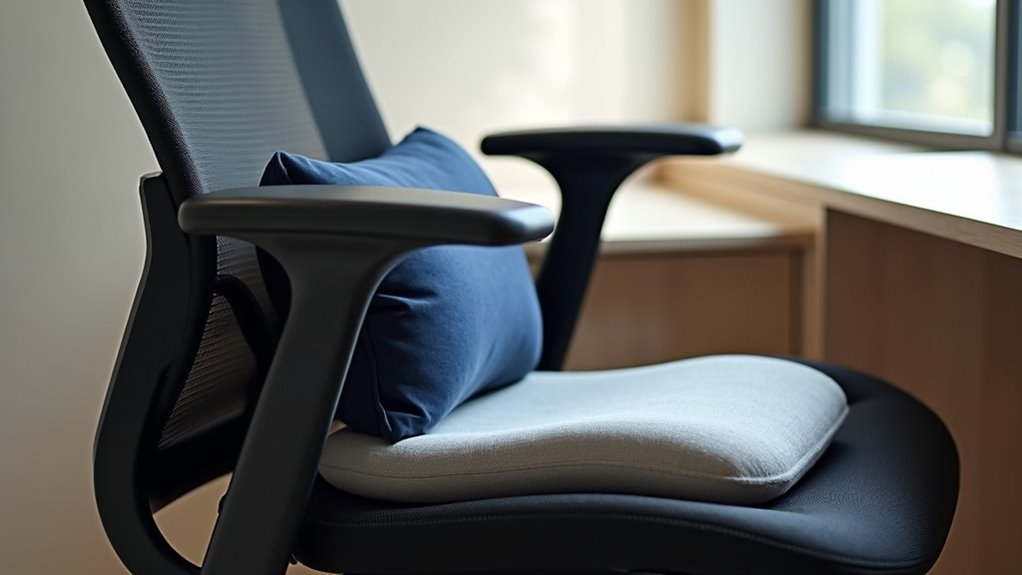How to Make an Uncomfortable Office Chair Comfortable
This post contains affiliate links. As an Amazon Associate, we earn from qualifying purchases.
To make your office chair comfortable, begin by adding lumbar support to properly support your back. Adjust the chair height so your feet are flat on the ground or on a footrest, ensuring your knees are at a 90-degree angle. The backrest angle is also important; aim for a position between 90-110 degrees. Additionally, consider the armrests—keep them close to your body and padded for enhanced comfort. Further tips and explanations will follow to help transform your chair into a cozy throne.
Essential Facts in 30 Seconds
- Adjust chair height for flat feet and 90-degree knee angle to improve posture.
- Use a lumbar support cushion to maintain spine’s natural curve and alleviate lower back pain.
- Incorporate a gel or memory foam seat cushion for added comfort and weight distribution.
- Position armrests close and adjust height to keep forearms parallel to the floor, minimizing shoulder strain.
- Use a footrest to support feet, encourage better posture, and enhance circulation during long sitting periods.
Introducing Lumbar Support
Lumbar support is essential for any office chair. It keeps your lower back happy and healthy. Good lumbar support helps maintain the natural curve of your spine. This can reduce the risk of lower back pain. No one wants that discomfort!
Spinal alignment is crucial too. It helps you sit up straight and avoid slouching. There are different types of lumbar support: fixed, adjustable, and inflatable. Research indicates that ergonomic workstations can significantly reduce lost workdays; this highlights the importance of having proper lumbar support in your office chair. A well-designed chair can improve posture and enhance your overall sitting experience. Remember, proper backrest alignment is vital for long-term health and comfort. Proper lumbar support contributes to reducing discomfort and enhancing focus during long hours at a desk.
Adjustable lumbar supports are great. They let you customize the fit to match your back’s curve. Just make sure it’s positioned correctly. Not too high or too low. You don’t want to feel like a pretzel!
Using lumbar support boosts your comfort. It also makes you more productive. An ergonomic chair with good lumbar support is a smart choice. Your back will thank you, and you can work without aches.
Enjoy smooth sailing at your desk!
Enhancing Cushioning

Level up your office chair comfort by enhancing cushioning.
Start with cushion thickness. A cushion that’s 2 to 3 inches thick offers great comfort and support. For minimal padding, choose a 1 to 2-inch cushion. If back pain is a concern, consider a thicker 3 to 4-inch memory foam option. Ideal thickness for an office seat cushion ensures that you find the right support level for your body. Additionally, proper height of the chair is crucial for maximizing overall comfort while seated. Choosing the right cushion aids in blood circulation, which can help reduce thigh pressure and improve comfort. Regular breaks also play a vital role in preventing aches and maintaining overall comfort during long hours of sitting.
Next, think about materials. Memory foam is excellent. It molds to your body and spreads weight evenly. Gel cushions are great for keeping cool. High-density foam is durable and keeps its shape over time.
Armrests matter too. Padded armrests, especially in memory foam, protect your elbows.
Spills happen. Make sure your cushion covers are washable.
With these tips, you can create a super comfy workspace!
Adjusting Chair Height
Getting your chair height right is key for comfort. Feet should be flat on the floor or on a footrest. Knees need to bend at about a 90-degree angle. This position helps keep your back comfortable and prevents knee pain. Proper chair height adjustment is essential for maintaining an ergonomic workspace, as it can help prevent slouching and promote better posture. Adjusting your workspace according to proper office ergonomics can also enhance your overall productivity. A height that allows your knees to be slightly lower than your hips can further improve posture and comfort. Adjust your chair using the lever or try cushions if needed. A good height helps you sit well and stay focused.
Happy sitting!
Optimal Seat Height
Finding the right seat height for your office chair can change everything. Here’s how to get it just right for comfort:
- Measure from the floor to the underside of your kneecap.
- Sit down with your feet flat. Bend your knees at about 90 degrees. Make sure it feels good.
- Adjust your chair. Your knees should be slightly lower than your hips. This keeps your back happy and allows for proper positioning to reduce discomfort. Proper height adjustment can also help distribute weight evenly and minimize strain on your legs.
- Align your armrests with your desk. This helps keep your arms relaxed.
With the right seat height, you’ll feel great. You can tackle your workday without aches! Additionally, ensure that your adjustments maintain proper posture while seated, as this is crucial for long-term comfort.
Get comfy and focus on what matters.
Footrest Utilization
A comfy footrest can change your office setup! It’s not just for resting your feet. Using a footrest has many benefits.
A footrest helps when your chair is too high. It keeps your feet supported and reduces strain on your knees and back. You can shift your weight and improve blood flow. This helps you fight off fatigue during long hours. Additionally, using a footrest can enhance comfort during long meetings by promoting better posture and alignment. Proper sitting techniques can also alleviate strain on the lower back, making your seating experience even more comfortable. Maintaining an ergonomic position is essential for overall well-being while sitting.
Adjust the angle and height of your footrest. Find what feels best for you. Don’t keep your feet in one place. Move your legs around for comfort!
With these simple changes, you’ll sit better. You’ll feel good and be ready to tackle any work challenge!
Optimizing Backrest Angle and Support

Sitting in an office chair for long hours can be tough. The angle and support of your backrest play a big role in your comfort. Follow these steps to find the best setup for your backrest.
- Adjust the backrest angle: Aim for 90 to 110 degrees. A slight recline between 100-110 degrees relieves pressure on your spine, promoting correct sitting posture.
- Check lumbar support: Make sure it fits the curve of your lower back. This helps prevent slouching. If your chair doesn’t have good support, use a lumbar cushion.
- Set the height: The backrest should support your entire back. Adjust it so it fits your height for better comfort, ensuring your knees are at or slightly below hip level.
- Lock your settings: After finding your perfect position, lock the angle. This keeps your posture in check. Proper lumbar support reduces fatigue and promotes comfort to enhance your workspace experience.
With these tips, you can create a comfortable, supportive workspace.
Improving Armrest Comfort and Positioning

Armrests are important parts of your office chair. They help keep you comfortable while you work.
Adding padded armrest covers can make a big difference. Adjust their height to match your needs. This helps improve your posture. Proper positioning can reduce shoulder pain.
With these small changes, you can work longer without discomfort. Enjoy more hours of comfy working. That’s a great benefit!
Padded Armrest Covers
Padded armrest covers provide comfort for your elbows during long desk hours. The right materials offer great benefits. Here’s what to check for:
- Contoured Design: These covers fit your arm shape. They support you and help with posture, which is essential for preventing discomfort during extended use. Proper arm positioning can also enhance overall comfort throughout your workday.
- Breathable Mesh: This keeps your arms cool. No one likes sticky elbows!
- Pressure Relief: Thick padding reduces strain on your joints. Work feels easier with less discomfort.
- Durable Fastening: Easy to install. They stay in place while you type—no slipping allowed!
Additionally, ensure that your arm positioning aligns with proper ergonomics to promote overall comfort and reduce strain.
Upgrade your desk experience with padded armrest covers. Enjoy better comfort and support every day.
Adjustable Armrest Height
Getting comfy in your office chair involves more than just soft armrest covers. Adjustable armrest height is very important. Use armrest adjustment techniques to find the right height for you. Most chairs have buttons, levers, or ratchets for easy adjustments.
Make sure your elbows bend at a 90-degree angle. Your forearms should stay parallel to the floor. This setup helps reduce shoulder and neck tension.
Adjust the armrests while sitting in the chair. Make small changes until it feels just right. Once you find the perfect height, lock those armrests in place.
Don’t worry if you bump them accidentally. Just laugh it off. Everyone makes mistakes! Enjoy your new comfortable setup!
Proper Armrest Positioning
Armrests can make a big difference in comfort while you work. Proper armrest positioning helps reduce shoulder strain.
Follow these simple tips to find the right setup:
- Adjust armrest width: Keep armrests close to your body to avoid tension in your shoulders.
- Check armrest shape: Choose contoured designs that support your forearms better.
- Match armrest length: Armrests should support your forearms fully without bending your wrists.
- Align with your desk: Position them for comfortable arm placement while typing.
Make these adjustments. You’ll feel more comfortable and focused at your desk!
Incorporating Additional Ergonomic Accessories

Upgrade your office chair with ergonomic accessories. A lumbar pillow is a great start. It keeps your spine aligned and reduces back strain. Memory foam versions fit your body and provide excellent support during long hours.
Add more comfort with seat cushions and armrest pads. A good seat cushion relieves pressure points. It feels like sitting on a cloud. Adjustable armrests keep your arms relaxed and happy.
Don’t forget a footrest. It helps your legs stay comfy and improves circulation.
With these accessories, your chair becomes a comfort zone. Transform your workspace and watch your productivity soar!
Frequently Asked Questions
How Often Should I Take Breaks While Sitting?
Taking breaks every 30 to 60 minutes is essential while sitting. Short breaks improve blood flow and help reduce tiredness. They can also boost your focus and energy. This makes your workday more productive and enjoyable. Stand up, stretch, or walk around for a few minutes. Simple movements can refresh your mind and body. Remember, a little break goes a long way in keeping you healthy!
Can I Use a Standing Desk Instead?
Standing desks can help improve blood flow and support back health. They let you work while standing, which many people enjoy. But standing for too long can lead to tiredness and sore feet. Finding a mix of sitting and standing usually works best. This balance keeps you comfortable and helps you stay focused. Remember, your comfort matters for good work.
What Exercises Help Relieve Back Pain From Sitting?
Sitting for a long time can hurt your back. Simple stretches help. Try seated twists. They can loosen your spine. Gentle backbends also help.
Good posture is key. Sit up straight. Pull your shoulders back. Engage your core muscles. This supports your spine while you sit.
Take breaks often. Stand up and move around. Walk for a few minutes. This can reduce tightness in your back.
Use a chair that supports your lower back. A cushion can also help. Keep your feet flat on the floor.
These easy tips can help relieve back pain from sitting. Take care of your back and feel better!
How Do I Know if My Chair Is Too Big?
Check your chair size against your body. A chair that’s too big can cause problems. Slouching? Feet dangling? These signs show the chair might not fit. Your knees should sit comfortably at a right angle. Your feet should touch the ground. The back of the chair should support your lower back. Adjust the chair to feel good. Comfort matters. A good fit helps you sit better and work well.
Are There Specific Brands of Ergonomic Chairs You Recommend?
Choosing the right office chair brand is important for comfort. Look for ergonomic features like adjustability and quality materials. Herman Miller and Steelcase are top choices known for their comfort. They offer great support for long hours at a desk. Branch is also a good option. It provides great value without sacrificing quality. Prioritize your comfort and support when making a decision. Your back will thank you!
Conclusion
Making your office chair comfy can really boost your work vibe. A comfortable chair helps you feel better and work more efficiently. Adjust the lumbar support and armrests to fit your body. This simple change can make a big difference. No one wants a sore back from sitting too long. Use cushions for extra support and comfort. With the right adjustments, your chair can feel like a cozy throne. Get started on making those changes. You’ll thank yourself later!
